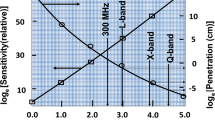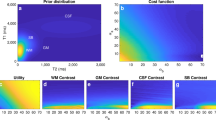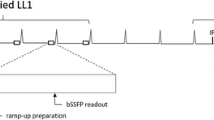Abstract
Objective
Purely phase-encoded techniques such as single point imaging (SPI) are generally unsuitable for in vivo imaging due to lengthy acquisition times. Reconstruction of highly undersampled data using compressed sensing allows SPI data to be quickly obtained from animal models, enabling applications in preclinical cellular and molecular imaging.
Materials and methods
TurboSPI is a multi-echo single point technique that acquires hundreds of images with microsecond spacing, enabling high temporal resolution relaxometry of large-R 2* systems such as iron-loaded cells. TurboSPI acquisitions can be pseudo-randomly undersampled in all three dimensions to increase artifact incoherence, and can provide prior information to improve reconstruction. We evaluated the performance of CS-TurboSPI in phantoms, a rat ex vivo, and a mouse in vivo.
Results
An algorithm for iterative reconstruction of TurboSPI relaxometry time courses does not affect image quality or R 2* mapping in vitro at acceleration factors up to 10. Imaging ex vivo is possible at similar acceleration factors, and in vivo imaging is demonstrated at an acceleration factor of 8, such that acquisition time is under 1 h.
Conclusions
Accelerated TurboSPI enables preclinical R 2* mapping without loss of data quality, and may show increased specificity to iron oxide compared to other sequences.









Similar content being viewed by others
References
Li L, Han H, Balcom BJ (2009) Spin echo SPI methods for quantitative analysis of fluids in porous media. J Magn Reson 198:252–260
Vashaee S, Marica F, Newling B, Balcom BJ (2015) A comparison of magnetic resonance methods for spatially resolved T 2 distribution measurements in porous media. Meas Sci Technol 26:055601
Prado PJ, Balcom BJ, Mastikhin IV, Cross AR, Kennedy CB, Armstrong RL, Logan A (1999) Magnetic resonance imaging of gases: a SPRITE study. J Magn Reson 137:342–352
Subramanian S, Devasahayam N, Matsumoto S, Saito K, Mitchell JB, Krishna MC (2012) Echo-based single point imaging (ESPI): a novel pulsed EPR imaging modality for high spatial resolution and quantitative oximetry. J Magn Reson 218:105–114
Ramos-Cabrer P, van Duynhoven J, der Toorn AV, Nicolay K (2004) MRI of hip prostheses using single-point methods: in vitro studies towards the artifact-free imaging of individuals with metal implants. Magn Reson Imaging 22:1097–1103
Wiens CN, Artz NS, Jang H, McMillan AB, Koch KM, Reeder SB (2016) Broadband single point imaging with ultra-short echo times for imaging near metallic implants. In: Proceedings of the ISMRM workshop on data sampling and image reconstruction, p 16
Beyea SD, Balcom BJ, Prado PJ, Cross AR, Kennedy CB, Armstrong RL, Bremner TW (1998) Relaxation Time mapping of short T 2* nuclei with single-point imaging (SPI) methods. J Magn Reson 134(1):156–164
Beyea SD, Altobelli SA, Mondy LA (2003) Chemically selective NMR imaging of a 3-component (solid–solid–liquid) sedimenting system. J Magn Reson 161(2):198–203
Parasoglou P, Malioutov D, Sederman A, Rasburn J, Powell H, Gladden L, Blake A, Johns M (2009) Quantitative single point imaging with compressed sensing. J Magn Reson 201:72–80
Robson MD, Bydder GM (2006) Clinical ultrashort echo time imaging of bone and other connective tissues. NMR Biomed 216:152–160
Balcom BJ, MacGregor R, Beyea SD, Green D, Armstrong RL, Bremner TW (1996) Single-point ramped imaging with T1 enhancement (SPRITE). J Magn Reson A 123:131–134
Beyea SD, Balcom BJ, Mastikhin IV, Bremner TW, Armstrong RL, Grattan-Bellew PE (2000) Imaging of heterogeneous materials with a turbo spin echo single-point imaging technique. J Magn Reson 144:255–265
Rioux JA, Brewer KD, Beyea SD, Bowen CV (2012) Quantification of superparamagnetic iron oxide with large dynamic range using TurboSPI. J Magn Reson 216:152–160
Bowen CV, Zhang X, Saab G, Gareau PJ, Rutt BK (2002) Application of the static dephasing regime theory to superparamagnetic iron-oxide loaded cells. Magn Reson Med 48(1):52–61
Halse M, Goodyear DJ, MacMillan B, Szomolanyi P, Matheson D, Balcom BJ (2003) Centric scan SPRITE magnetic resonance imaging. J Magn Reson 165:219–229
Candes E, Tao T (2004) Near optimal signal recovery from random projections: universal encoding strategies? IEEE Trans Inf Theory 52:5406–5425
Donoho DL (2006) Compressed sensing. IEEE Trans Inf Theory 52:1289–1306
Lustig M, Donoho D, Pauly JM (2007) Sparse MRI: the application of compressed sensing for rapid MR imaging. Magn Reson Med 58:1182–1195
Cukur T, Lustig M, Nishimura DG (2009) Improving non-contrast-enhanced steady-state free precession angiography with compressed sensing. Magn Reson Med 61:1122–1131
Kampf T, Fischer A, Basse-Lusebrink T, Ladewig G, Breuer F, Stoll G, Jakob P, Bauer W (2010) Application of compressed sensing to in vivo 3D 19F CSI. J Magn Reson 207:262–273
Majumdar A, Ward RK (2011) Accelerating multi-echo T2 weighted MR imaging: analysis prior group-sparse optimization. J Magn Reson 210:90–97
Adluru G, DiBella EVR (2008) Reordering for improved constrained reconstruction from undersampled k-space data. Int J Biomed Imaging. doi:10.1155/2008/341684
Samsonov A, Jung Y, Alexander AL, Block WF, Field AS (2008) MRI compressed sensing via sparsifying images. In: Proceedings of the 16th scientific meeting. International Society for Magnetic Resonance in Medicine. Toronto, p 342
Wu B, Millane RP, Watts R, Bones PJ (2011) Prior estimate-based compressed sensing in parallel MRI. Magn Reson Med 65:83–95
Chen GH, Tang J, Leng S (2008) Prior image constrained compressed sensing (PICCS): a method to accurately reconstruct dynamic CT images from highly undersampled projection data sets. Med Phys 35:660–663
Fischer A, Breuer F, Blaimer M, Seiberlich N, Jakob PM (2008) Accelerated dynamic imaging by reconstructing sparse differences using compressed sensing. In: Proceedings of the 16th scientific meeting. International Society for Magnetic Resonance in Medicine. Toronto, p 341
Parasoglou P, Sederman A, Rasburn J, Powell H, Johns M (2008) Optimal k-space sampling for single point imaging of transient systems. J Magn Reson 194:99–107
Knoll F, Clason C, Diwoky C, Stollberger R (2011) Adapted random sampling patterns for accelerated MRI. Magn Reson Mater Phy 24:43–50
Vaswani N, Lu W (2010) Modified-CS: modifying compressive sensing for problems with partially known support. IEEE Trans Signal Process 58:4595–4607
Gravina S, Cory D (1994) Sensitivity and resolution of constant-time imaging. J Magn Reson 104:53–61
Posse S, Otazo R, Dager SR, Alger J (2013) MR spectroscopic imaging: principles and recent advances. J Magn Reson Imaging 37:1301–1325
Bowen CV, Gati JS, Menon RS (2006) Robust prescan calibration for multiple spin-echo sequences: application to FSE and b-SSFP. Magn Reson Imaging 24(7):857–867
Busse RF, Brau AC, Vu A, Michelich CR, Bayram E, Kijowski R, Reeder SB, Rowley HA (2008) Effects of refocusing flip angle modulation and view ordering in 3D fast spin echo. Magn Reson Med 60:640–649
Rioux JA, Bowen CV, Kiselev VG (2012) Relaxation with diffusion near magnetic particles and cells: analytical description and experiment. In: Proceedings of the 20th scientific meeting. International Society for Magnetic Resonance in Medicine. Melbourne, p 1712
Gamper U, Boesiger P, Kozerke S (2008) Compressed sensing in dynamic MRI. Magn Reson Med 59:365–373
Doneva M, Bornert P, Eggers H, Stehning C, Senegas J, Mertins A (2010) Compressed sensing reconstruction for magnetic resonance parameter mapping. Magn Reson Med 64:1114–1120
Zur Y (2000) Design of improved spectral-spatial pulses for routine clinical use. Magn Reson Med 43:410–420
Arbab AS, Frenkel V, Pandit SD, Anderson SA, Yocum GT, Bur M, Khuu HM, Read EJ, Frank JA (2006) Magnetic resonance imaging and confocal microscopy studies of magnetically labeled endothelial progenitor cells trafficking to sites of tumor angiogenesis. Stem Cells 24:671–678
Acknowledgments
JAR acknowledges funding from the Natural Sciences and Engineering Research Council (NSERC) Vanier Canada Graduate Scholarship program and the Killam Foundation. CVB and SDB acknowledge funding from the NSERC Discovery Grant program. Some research support during the preparation of this manuscript was provided by an investigator-sponsored research grant from GE Healthcare. Thanks to Kim Brewer, Erin Mazerolle, Christa Davis and Iulia Dude for assistance with the animal imaging experiments.
Author information
Authors and Affiliations
Corresponding author
Ethics declarations
Conflict of interest
The authors declare that they have no conflict of interest.
Ethical statement
All applicable international, national, and/or institutional guidelines for the care and use of animals were followed. All procedures performed in studies involving animals were in accordance with the ethical standards of the institution or practice at which the studies were conducted, with protocols approved by the Dalhousie University Care for Laboratory Animals committee. This article does not contain any studies with human participants performed by any of the authors.
Electronic supplementary material
Below is the link to the electronic supplementary material.
Supplementary material 1 (AVI 26581 kb)
Rights and permissions
About this article
Cite this article
Rioux, J.A., Beyea, S.D. & Bowen, C.V. 3D single point imaging with compressed sensing provides high temporal resolution R 2* mapping for in vivo preclinical applications. Magn Reson Mater Phy 30, 41–55 (2017). https://doi.org/10.1007/s10334-016-0583-y
Received:
Revised:
Accepted:
Published:
Issue Date:
DOI: https://doi.org/10.1007/s10334-016-0583-y




